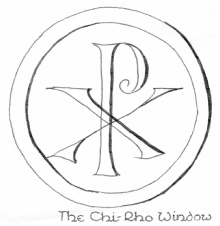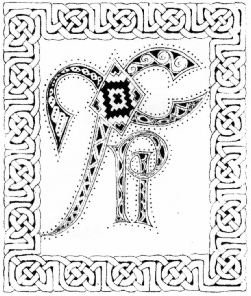



The Parish Church of St George the Martyr, Waterlooville

Rod spent his early years as a server, choirboy and crucifer at the Church of St Edmund KM, in Northwood Hills, Middlesex. Above the altar was a circular window and he was intrigued by the device upon it. This seemed to consist of a capital letter P with a saltire cross on its stem. He was told that the vertical of the P doubled as a capital I and that the whole represented a monogram of Christ. This device can also be seen on monuments, ecclesiastical vestments and elsewhere -
Festival Edition 2010
The Monogram of Christ
Later he learned that the cross was the Greek letter X (Ch), the P was in fact the Greek P (Rho) and that the monogram XPI comprised the first three letters of Christ in the Greek alphabet.
Tradition has it that the Emperor Constantine 1 (AD274-
Whilst at the Holy Island of Lindisfarne a few years ago, Rod examined a facsimile of the Lindisfarne Gospels, where he observed an artistic variation of the Chi-
Rod, being interested in calligraphy and illumination, encouraged his students to devise their own artwork in the Chi-
Rod Dawson

